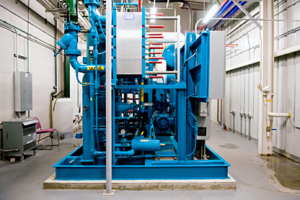Chiller redundancy provides increased reliability and energy efficiency.
Manufacturers build redundancy into many operations in a facility, so why not into the chillers? This single question opens the door to a host of others:
- How much does it cost when a chiller is down for an hour, a day or longer?
- How do you build redundant capability into a cooling system, and how much do you need?
- Downtime can be minimized with proper maintenance and by stocking replacement parts. But what can you do to nearly eliminate downtime?
To answer all these questions, it is necessary to examine the ramifications of the extreme scenarios.
 At one end of the spectrum, a redundant chiller for each and every one of your operations would provide total redundancy. On the upside, this scenario would virtually eliminate the potential for downtime. The downside to this is that it would double the initial capital investment required, increase maintenance costs and double the floor space required.
At one end of the spectrum, a redundant chiller for each and every one of your operations would provide total redundancy. On the upside, this scenario would virtually eliminate the potential for downtime. The downside to this is that it would double the initial capital investment required, increase maintenance costs and double the floor space required.
At the other end of the spectrum is no redundancy at all. When a problem with a chiller occurs, the operation is down until the chiller is fixed or replaced. At the very least, this facility should consider stocking spare parts, especially those that may have a long lead time.
What can you do that is between these two extremes? One option would be to stock an extra chiller. This works well if your facility has multiple machines with an individual chiller on each machine whose requirements are the same or very similar. Like the spare tire in your car, this extra chiller becomes a temporary replacement if any of your chillers has a problem. This works best if the chillers are smaller in size and easy to move. Quick connects on the piping and power would ease the transition time.
If the chillers are larger but again similar in size and function, you can still back up those chillers. Say you have two chillers of 20 tons of cooling each. Add a third chiller for redundancy. Pipe the chillers with isolation valves so that the redundant chiller could be used to provide cooling for either of the two original chillers. If you have multiple chillers and piping them together would be too complicated and expensive, you can always set up your redundant chiller with hoses and connect the redundant chiller to the system that is having a cooling problem.
N+1: The Ideal Solution?
Redundancy can be achieved with an N+1 design, where N is the number of cooling circuits required for cooling the heat load and +1 is the redundancy. This type of redundancy will provide one extra refrigeration circuit that can be used to back up the other refrigeration circuits in the system.
For example, on a system requiring 20 tons of cooling, the standard chiller might incorporate two refrigeration circuits of 10 tons each to provide the necessary cooling. The N+1 design would use three circuits with each providing 10 tons of cooling. The first two circuits would provide the 20 tons of cooling required while the third provides the redundancy desired. In this case, redundancy is achieved with approximately 50 percent additional cost.
On a larger scale, consider an example where 240 tons of cooling are required. A standard chiller may consist of four modules of 60 tons each. A fifth 60-ton module would provide N+1 redundancy. In this case, redundancy is achieved with approximately 25 percent additional costs.
Ideally, in any N+1 design, the redundant circuit is rotated into the cooling process on a regular basis. This will equalize compressor run time and ensure that the backup circuit is in working order when it is needed the most.
Building redundancy into your cooling system will decrease your downtime when compared to systems without redundancy. With the N+1 design, as the number of circuits and modules increase, the cost of redundancy goes down. Energy efficiency is the added bonus. With more cooling circuits, the chiller will use only the number of cooling circuits required to match the heat load. N+1 design also increases the lifespan of your chiller by spreading the run time over several cooling circuits.
Written by Dimplex Thermal Solutions, this article was originally published in Process Cooling magazine.





